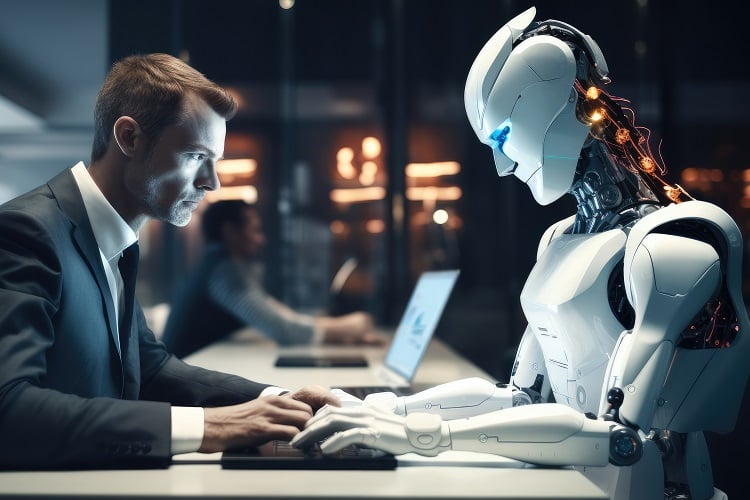It’s no secret that the explosion of AI created a spectacular technological revolution. Societies can look forward to many more exciting developments in the near years as the AI industry is significantly forecasted to grow to around $15.7 trillion by 2030. At this point, businesses looking to be competitive in the artificial intelligence space would hurry to make use of AI systems and integrate the technology into their workflows and products.
Since there is a shortage of IT skills in businesses, the democratization of AI has led to even more chances for innovation and has the ability to democratize technology for both technical and non-technical workers across all organizational levels.
Democratized AI means that the tools of artificial intelligence are coming out of the domain of the few and becoming easier to use. Such an environment would, literally, “level the playing field” according to Gartner, declaring democratized AI “one of the most disruptive trends of this decade.”.
Democratized AI offers businesses a lot of promise, but in order to realize its full potential and reduce risks, ethical Artificial intelligence development and responsible development are required. Because AI solutions educated on biased data have the potential to produce poor decisions and perpetuate unfair outcomes, the issues posed by democratized AI must be carefully considered.
What Advantages Does Democratized AI Offer?
Artificial Intelligence is quickly changing the way we work by helping with tasks like content creation, data analysis, and idea generation. More staff may now access this “democratized” AI, which encourages experimentation and creative problem-solving.
AI tools are accessible to and used by employees with a variety of skill sets, democratizing information and encouraging wider engagement. In addition, AI is capable of analyzing enormous volumes of data to offer insights and suggestions that promote more objective and well-informed decision-making.
Creativity
With the use of AI technologies, AI development companies may try out various concepts and strategies without having to invest a lot of money up front. This encourages creativity and taking calculated risks, which could result in ground-breaking discoveries. There is little coding needed to access a variety of AI tools and services through platforms like Microsoft Azure Cognitive Services and Google Cloud AI Platform.
Collaboration
Collaboration is the ideal setting for artificial intelligence to flourish. AI-enabled tools such as Miro and Mural combine brainstorming, concept visualization, and real-time feedback to promote group creativity.
AI systems for idea generation, such as Brainstorm.me and IdeaScale, enable group ideation by gathering ideas, examining them for patterns and trends, and making recommendations for fresh approaches. Teams can overcome creative blockages and provide a variety of solutions by doing this.
Huge datasets can be analyzed by AI solutions to find hidden relationships and patterns that inspire creative thinking. In order to find new prospects, tools such as IBM Watson Studio and Dataiku are used to evaluate competitor data, market trends, and client feedback.
Data Analysis
AI-driven solutions, including Tableau and Power BI, automate tasks for data cleaning, preparation, and visualization, thus empowered staff will be able to see conclusions quickly from large and complex datasets without any specialist knowledge.
AI can do this by analyzing past information to predict future trends and outcomes. Proactive decision-making is made possible by tools such as Microsoft Azure Machine Learning and Amazon SageMaker, which estimate sales, equipment breakdowns, and customer turnover.
Content Creation
Using particular prompts and styles, artificial intelligence (AI) is used by content creation tools such as Copy.ai and Jasper to generate text formats such as blog posts, social media captions, and marketing copy. This accelerates the production of material and frees up time for human editing and customization.
AI may customize language, tone, and graphics in content to fit the preferences of specific users or market categories. Customer data is analyzed by programs like Adobe Sensei and Persado to produce content that is more impactful and engaging.
Making Decisions
AI-driven insights are changing the scene of decision-making by going through tons of data, discovering patterns that no human eye can, and coming up with unbiased views. That makes it much more fair and effective, bridging the gap of human bias with data-driven decisions.
Artificial intelligence development has the capacity to troll through large reams of data, recognizing patterns and connections that may elude human analysts. This provides decision-makers with a thorough understanding of circumstances at hand.
AI, therefore, helps the decision makers take proactive and preventive measures against such future events by using historical data for the prediction of those same future events.
AI is able to provide real-time insight into the procedures or changes in the market, hence enabling quick and well-decided adjustments for better responsiveness and agility in decision-making.
AI Beyond 2024
Because AI & ML provides a potent tool to solve a wide range of business operations, it has fundamentally changed the business landscape. As a result, stakeholders now face a new challenge: figuring out how to employ AI effectively in tandem with competitors’ efforts.
In the end, in order to achieve the competitive results that corporate executives want, efforts to integrate AI must have a larger, strategic goal. Leaders are moving swiftly to integrate AI technologies into their business operations due to the excitement surrounding AI and its rapid technological advancement. However, in order to guarantee the sustainability of their digital transformation initiatives, companies must approach the deployment of AI automation thoughtfully, even in the face of quick and innovative advancements.
The long-term viability of an enterprise’s AI integration plan will be strengthened by practical frameworks that encourage consistent, productive engagement with AI, despite the temptation to view any advances as positive. Future-proofing a strategy while taking into account the ways in which AI will develop and alter over the coming years is what will enable transformative business outcomes.
Businesses need to not just interact with AI, but do so quickly as it continues to gain prominence. Because of low-code choices, organizations will enable their teams to interact more efficiently, and non-technical staff members without a strong IT experience will be able to take on more complex jobs. AI-driven democratization of technology for businesses in 2024 and beyond promises a promising future brimming with unbridled creativity, inventiveness, and innovation.
Conclusion
Democratization of AI is a driving force. We can expect a future where artificial intelligence empowers people, transforms industries. Contributing to a more equitable and sustainable world by adopting responsible development, supporting human-AI collaboration, and placing a high priority on ethical considerations.
The secret to optimizing advantages and reducing risks is ensuring that people maintain control and make appropriate use of AI solutions. To implement responsible AI practices, upskill and reskill workforces, encourage open communication, and bring stakeholders from a variety of backgrounds together to debate the future of AI and create responsible solutions, organizations, individuals, and governments must work together.
AI’s democratization is a significant trend influencing the future. We can create a world that is more inventive, inclusive, and sustainable for everyone if we responsibly embrace its promise.
Keep an eye for more latest news & updates on Gossips!




